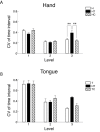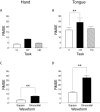Dual-task motor performance with a tongue-operated assistive technology compared with hand operations
- PMID: 22244362
- PMCID: PMC3287148
- DOI: 10.1186/1743-0003-9-1
Dual-task motor performance with a tongue-operated assistive technology compared with hand operations
Abstract
Background: To provide an alternative motor modality for control, navigation, and communication in individuals suffering from impairment or disability in hand functions, a Tongue Drive System (TDS) has been developed that allows for real time tracking of tongue motion in an unobtrusive, wireless, and wearable device that utilizes the magnetic field generated by a miniature disk shaped magnetic tracer attached to the tip of the tongue. The purpose of the study was to compare the influence of a concurrent motor or cognitive task on various aspects of simple movement control between hand and tongue using the TDS technology.
Methods: Thirteen young able-bodied adults performed rapid and slow goal-directed movements of hand and tongue (with TDS) with and without a concurrent motor (hand or tongue) or cognitive (arithmetic and memory) task. Changes in reaction time, completion time, speed, correctness, accuracy, variability of displacement, and variability of time due to the addition of a concurrent task were compared between hand and tongue.
Results: The influence of an additional concurrent task on motor performance was similar between the hand and tongue for slow movement in controlling their displacement. In rapid movement with a concurrent motor task, most aspects of motor performance were degraded in hand, while tongue speed during rapid continuous task was maintained. With a concurrent cognitive task, most aspects of motor performance were degraded in tongue, while hand accuracy during the rapid discrete task and hand speed during the rapid continuous task were maintained.
Conclusion: Rapid goal-directed hand and tongue movements were more consistently susceptible to interference from concurrent motor and cognitive tasks, respectively, compared with the other movement.
Figures






References
-
- Kandel ER, Schwartz JH, Jessell TM, Mack S, Dodd J. Principles of Neural Science. Elsevier New York; 1991.
-
- TongueTouch Keypad. http://www.newabilities.com
-
- Lau C, O'Leary S. Comparison of computer interface devices for persons with severe physical disabilities. American Journal of Occupational Therapy. 1993;47:1022–1030. - PubMed
-
- Jouse2. http://www.jouse.com
Publication types
MeSH terms
Grants and funding
LinkOut - more resources
Full Text Sources
Medical

